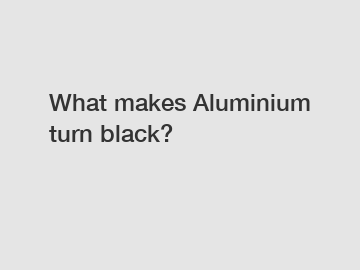What makes Aluminium turn black?
What Makes Aluminium Turn Black?
Aluminium, as a versatile and lightweight metal, is widely used in various industries. However, one common issue that can affect its appearance and functionality is the formation of black coloration on its surface. So, what causes aluminium to turn black? The blackening of aluminium can be attributed to several factors, including the formation of an oxide layer and the reaction with substances present in the environment.
The blackening of aluminium primarily occurs due to the formation of an oxide layer on its surface. When exposed to oxygen in the air, the outer layer of aluminium reacts with oxygen molecules to form aluminium oxide (Al2O3). This oxide layer is typically transparent and does not affect the appearance of the metal. However, when exposed to certain chemicals or high temperatures, this oxide layer can become porous, allowing other substances to enter and react with the aluminium.

One such reactive substance that causes aluminium to turn black is sulfur. When aluminium comes into contact with sulfur compounds such as hydrogen sulfide (H2S) or sulfur dioxide (SO2), a chemical reaction takes place, leading to the formation of aluminium sulfide (Al2S3). This black compound is responsible for the darkening of aluminium. Sulfur compounds can be found in various industrial processes, as well as naturally occurring in some environments, such as near volcanoes or in polluted air.
Additionally, the blackening of aluminium can also be accelerated by certain environmental factors, such as high humidity and pollutants. In humid conditions, moisture in the air can react with the aluminium surface, leading to the formation of aluminum hydroxide (Al(OH)3). This compound can further react with other substances, such as sulfur compounds, resulting in the formation of black compounds on the aluminium surface.
The blackening of aluminium not only affects its aesthetic appeal but also has significant implications for its functionality. The black compounds formed on the surface can decrease the reflectivity and conductivity of the metal, reducing its efficiency in applications such as heat transfer or electrical conductivity. Furthermore, the blackened surface may also be more susceptible to corrosion and degradation, leading to a shorter lifespan of the aluminium component.
To prevent or minimize the blackening of aluminium, various measures can be taken. Surface treatments, such as anodizing or coating with protective layers, can help create a barrier between the aluminium and reactive substances in the environment. Regular cleaning and maintenance can also remove any sulfur compounds or pollutants that may have accumulated on the surface. Additionally, controlling the humidity and environment in which aluminium is stored or used can help reduce the chances of blackening.
In conclusion, the blackening of aluminium is primarily caused by the formation of an oxide layer and the subsequent reaction with substances such as sulfur compounds. This phenomenon can have detrimental effects on the appearance, functionality, and lifespan of the metal. Understanding the factors that contribute to the blackening of aluminium allows for the development of preventive measures to maintain its integrity and optimize its performance in various applications.
For more information, please visit pvd on stainless steel, brushed brass sheet, china etching lift cabin suppliers.
189
0
0


Comments
All Comments (0)